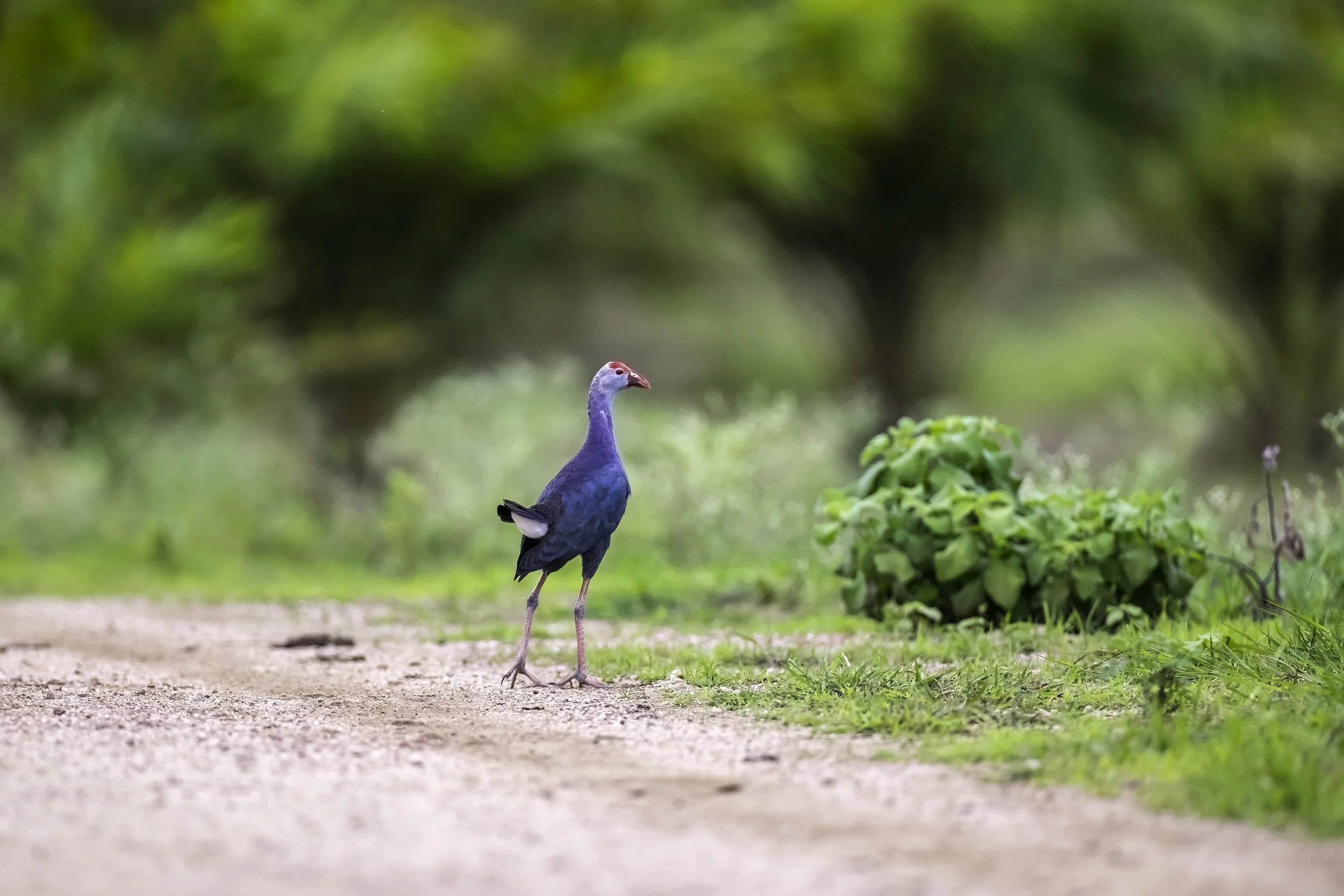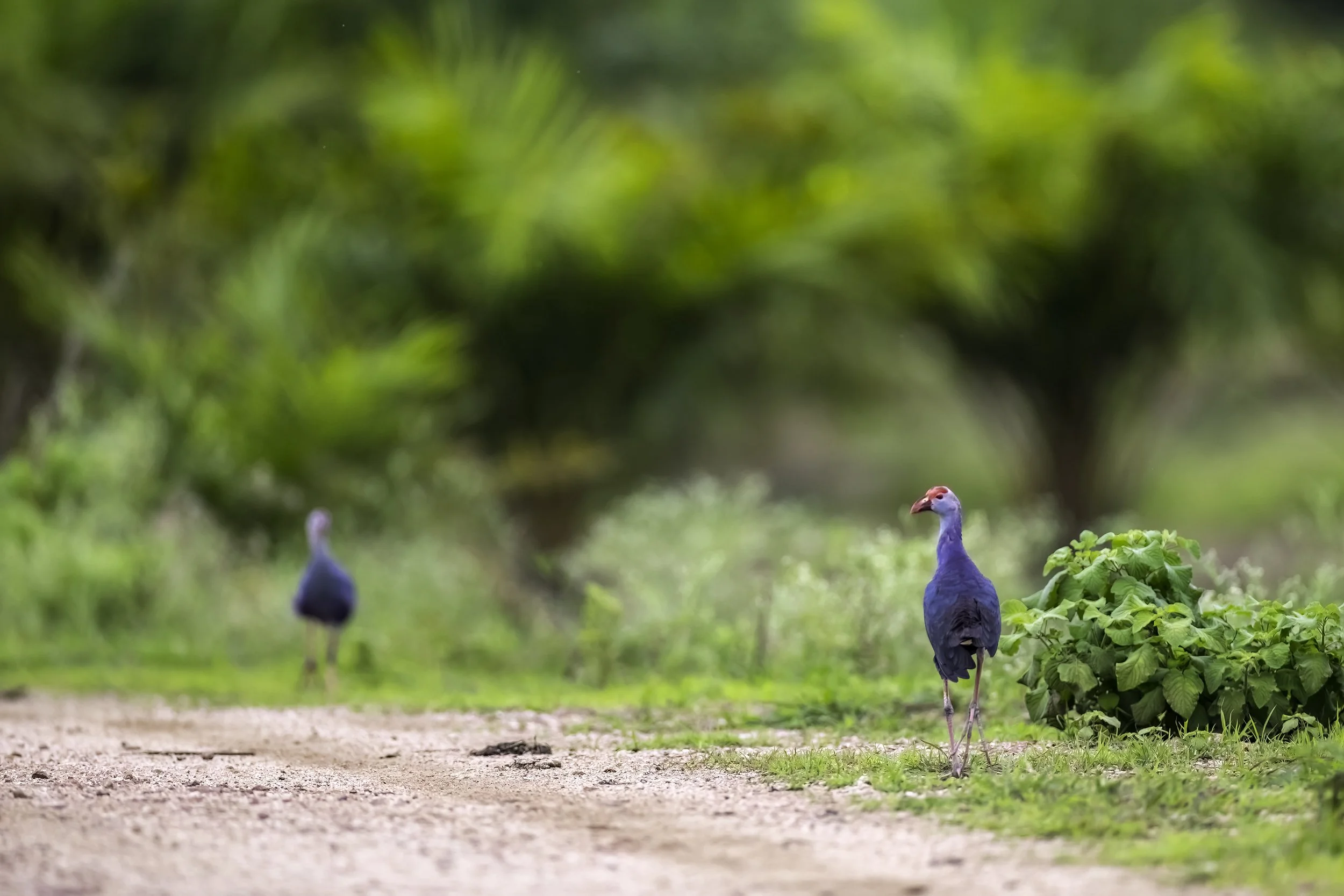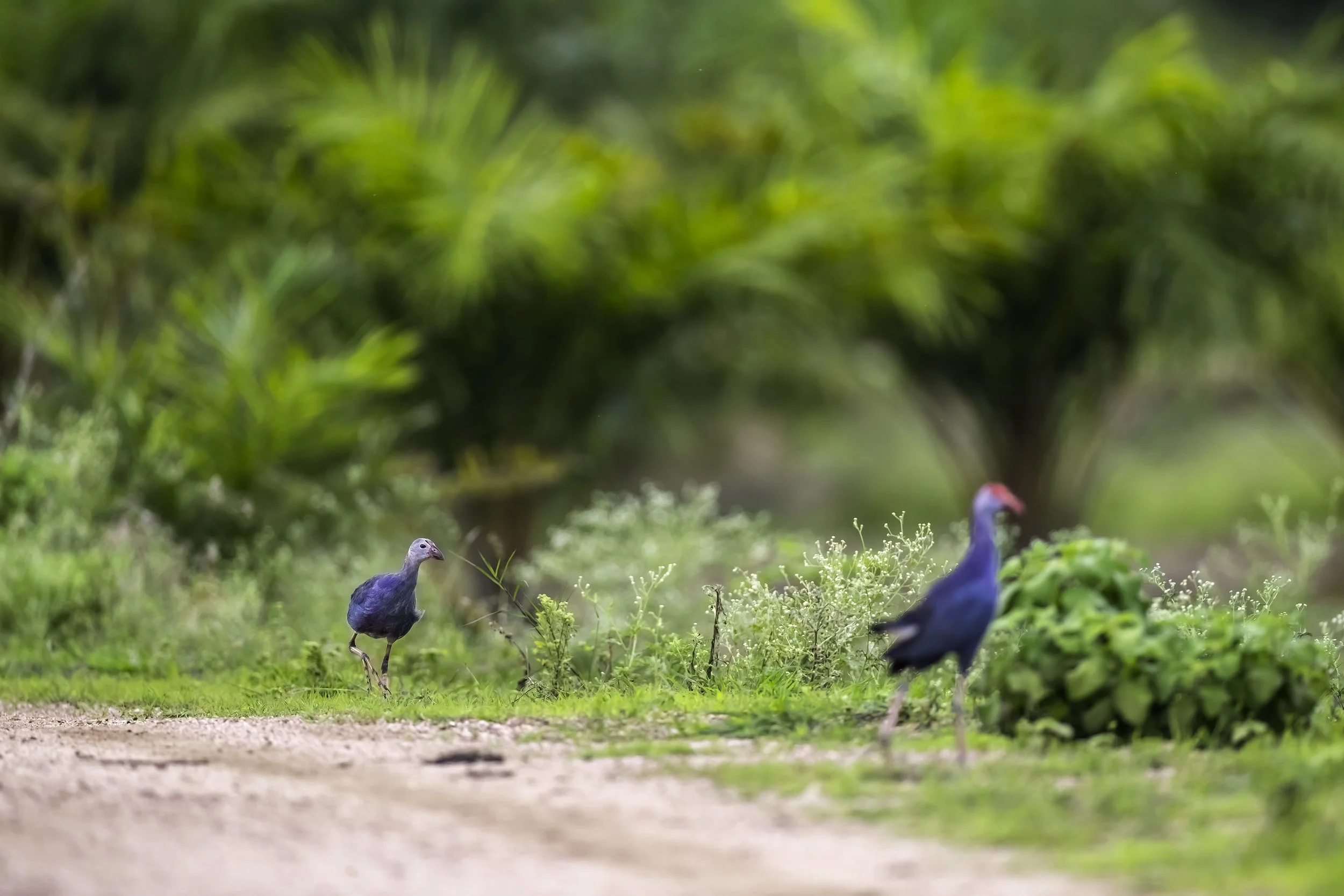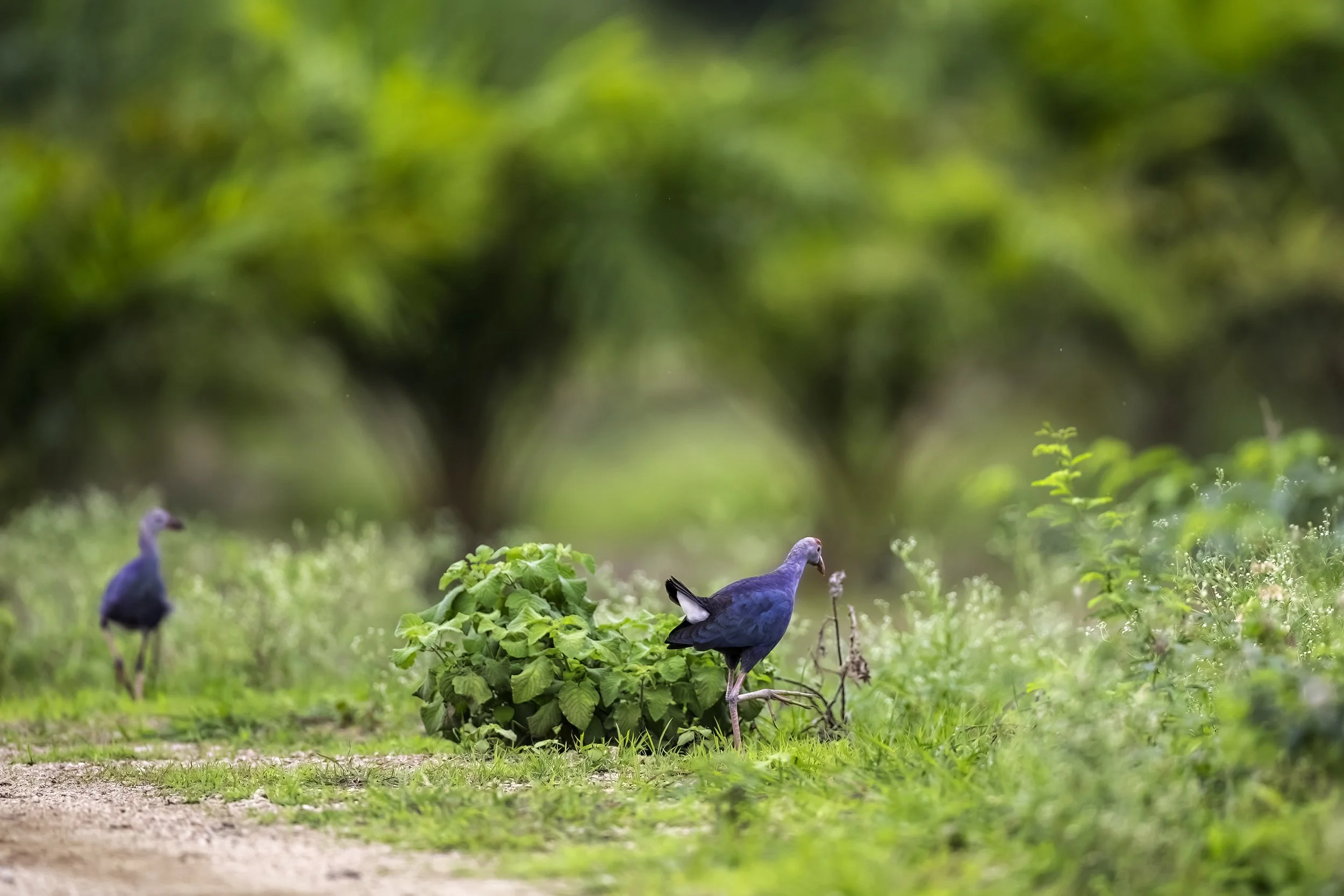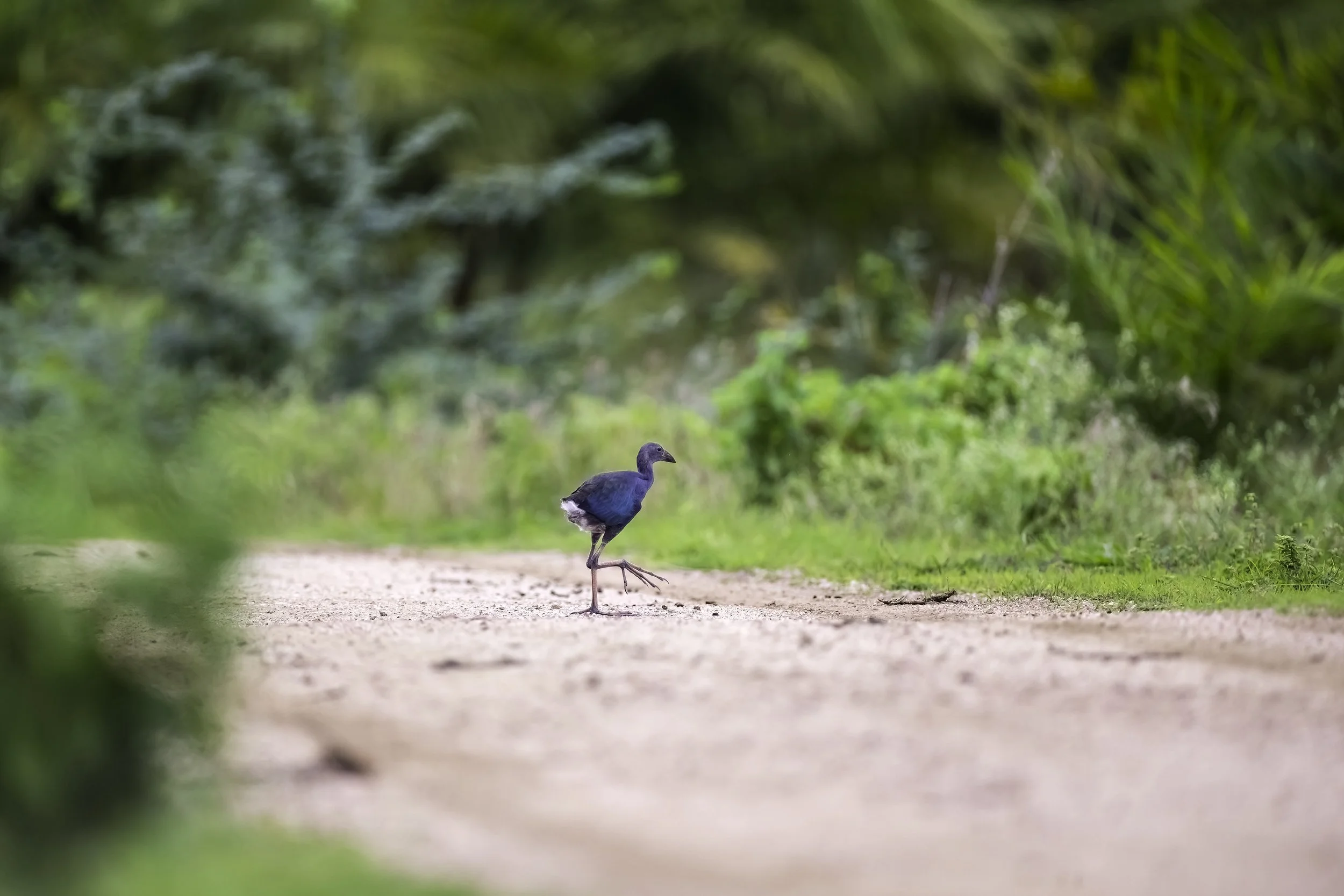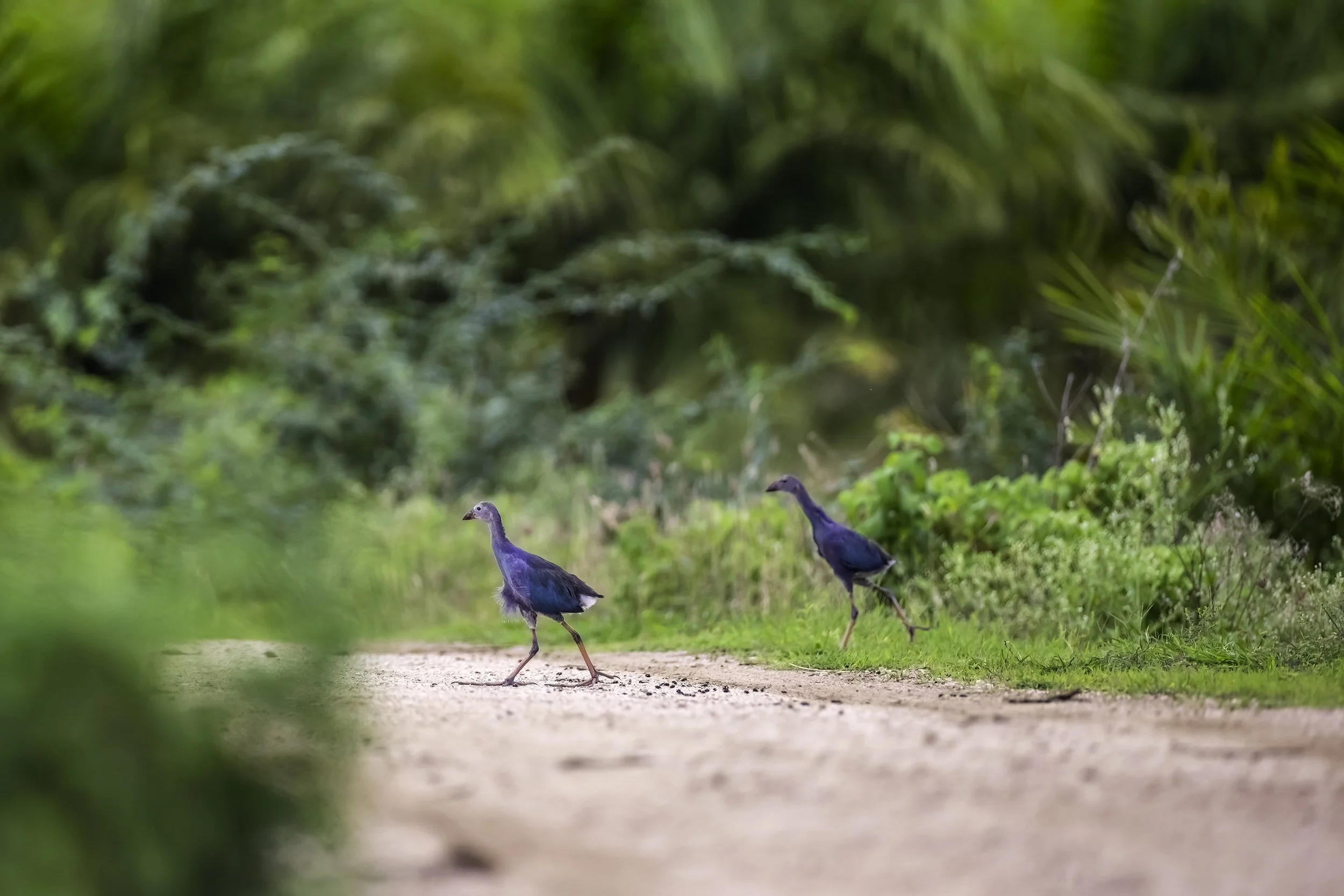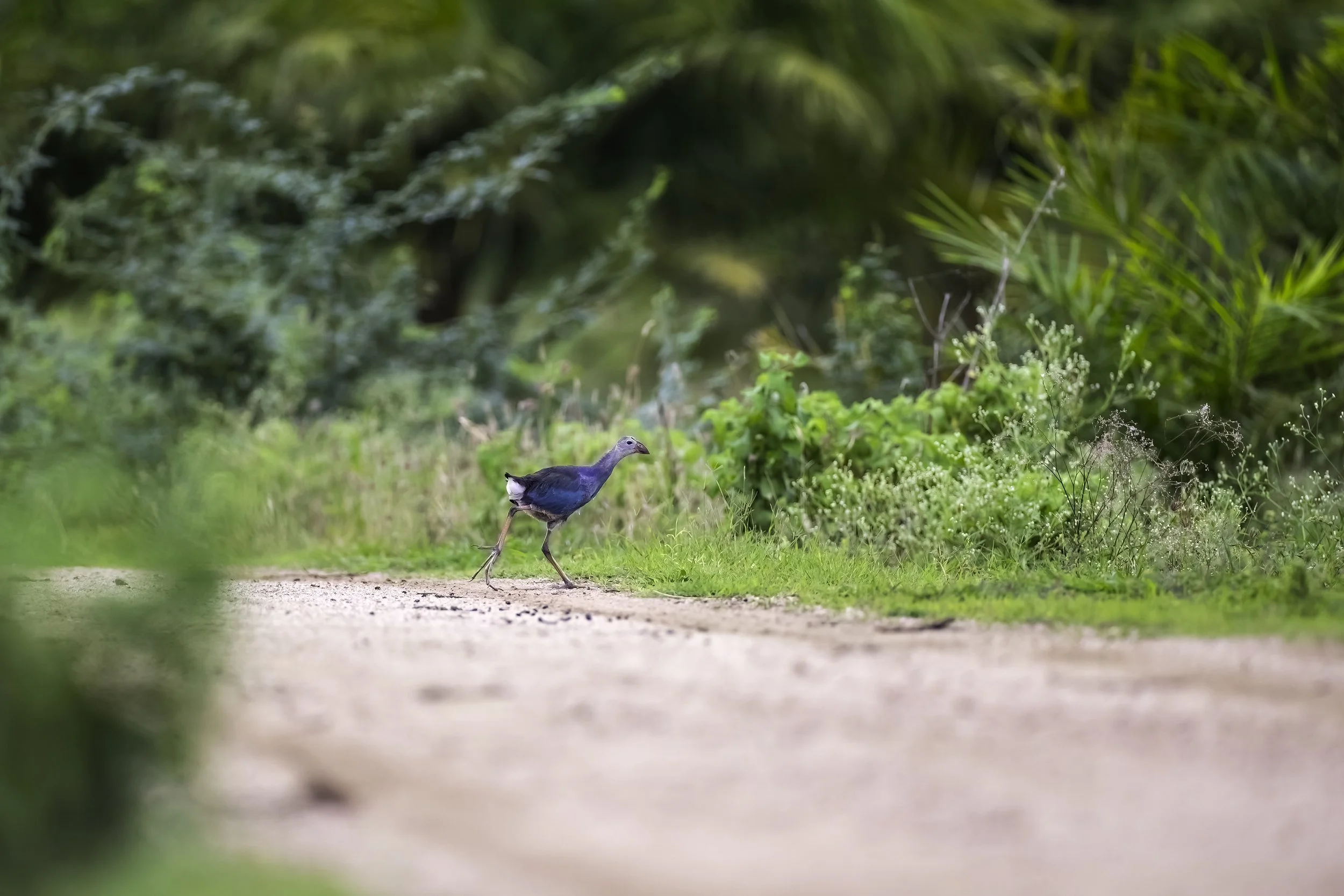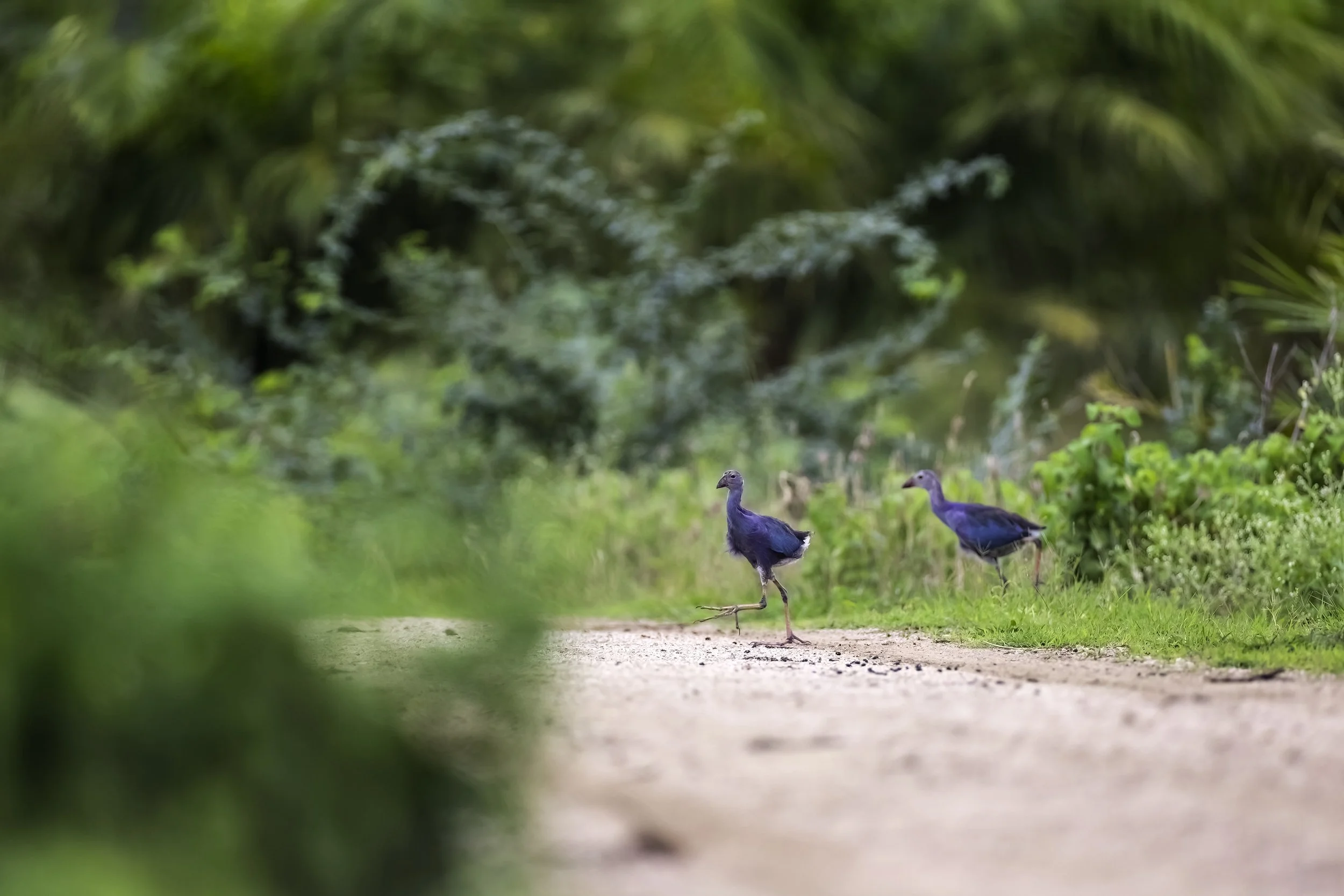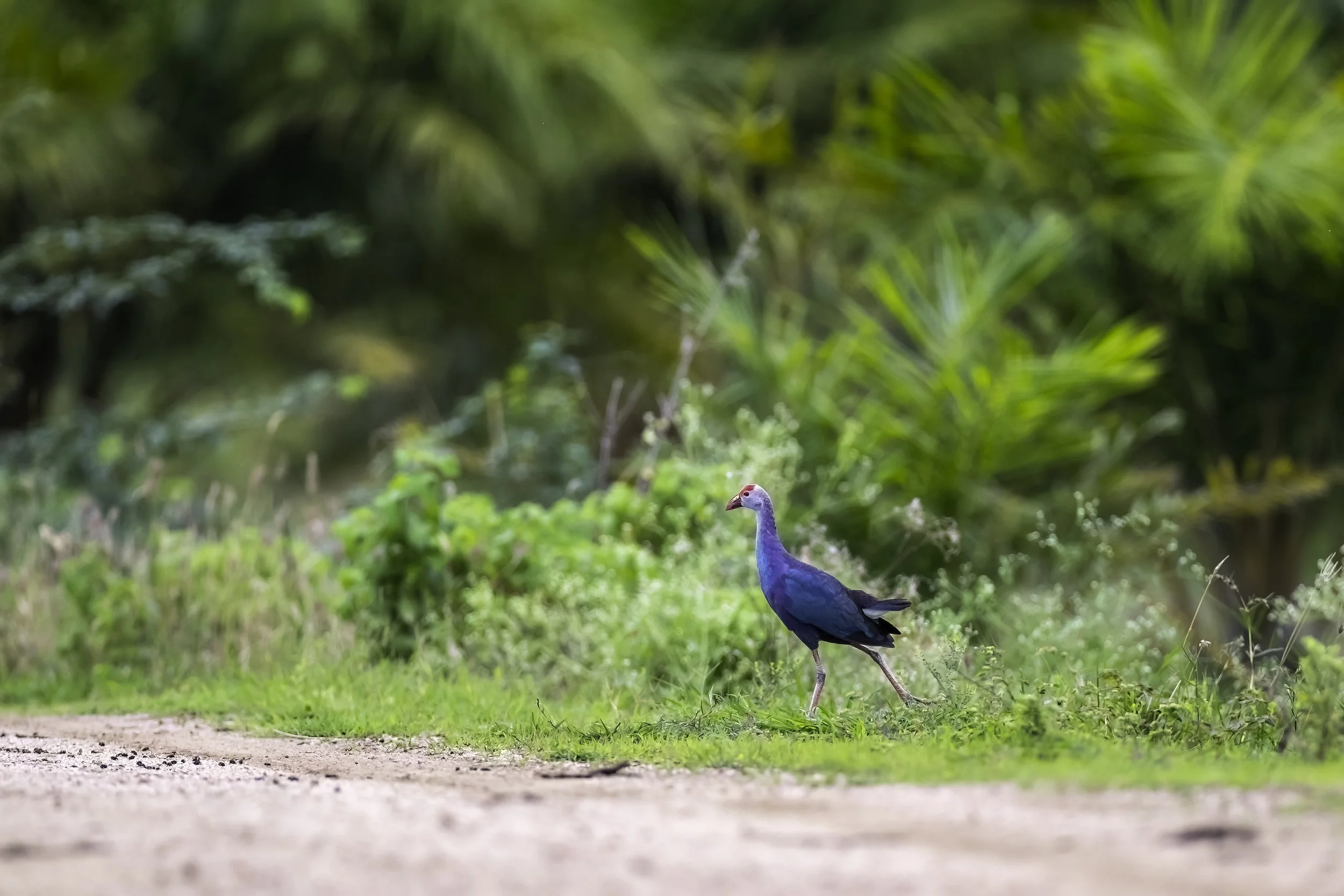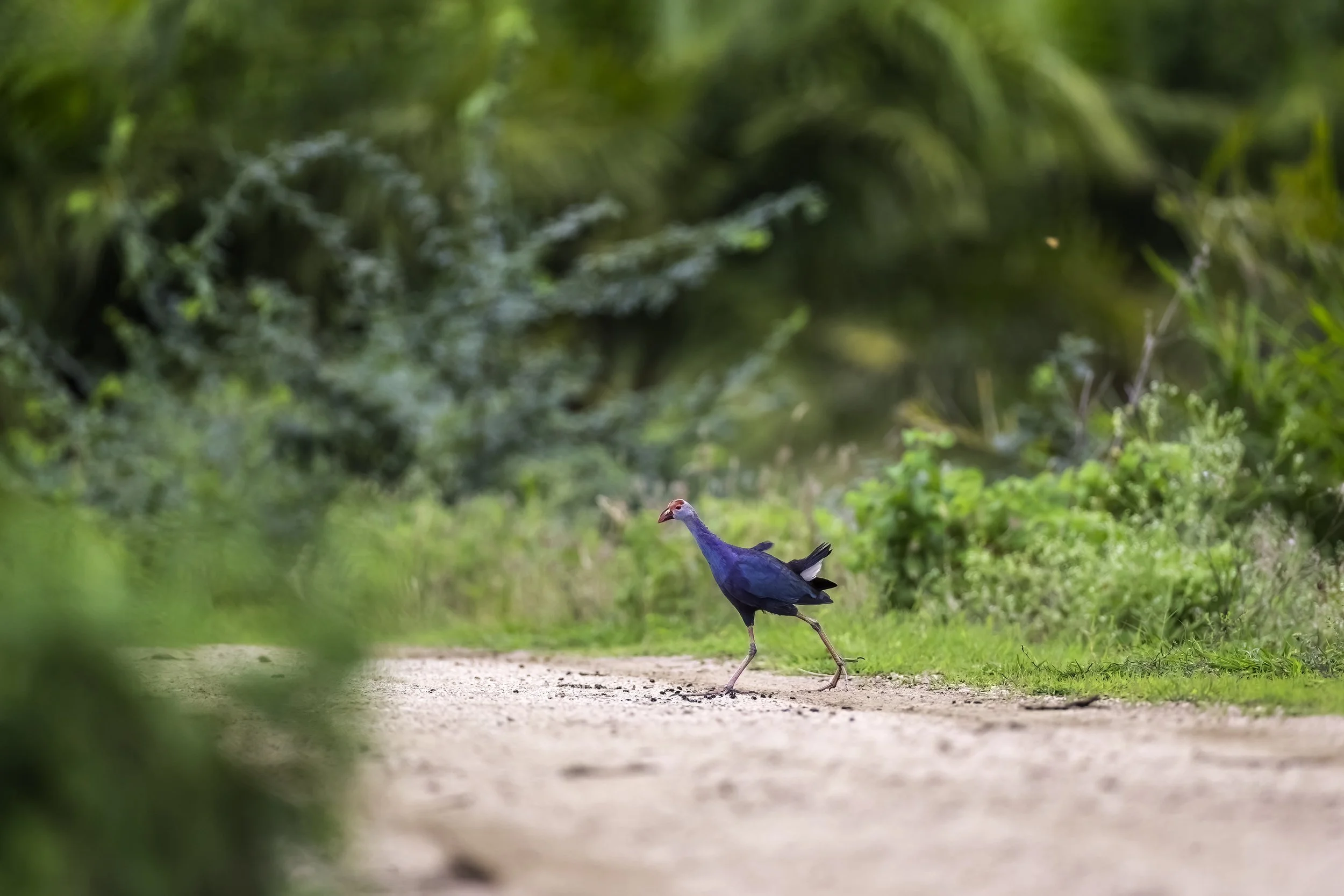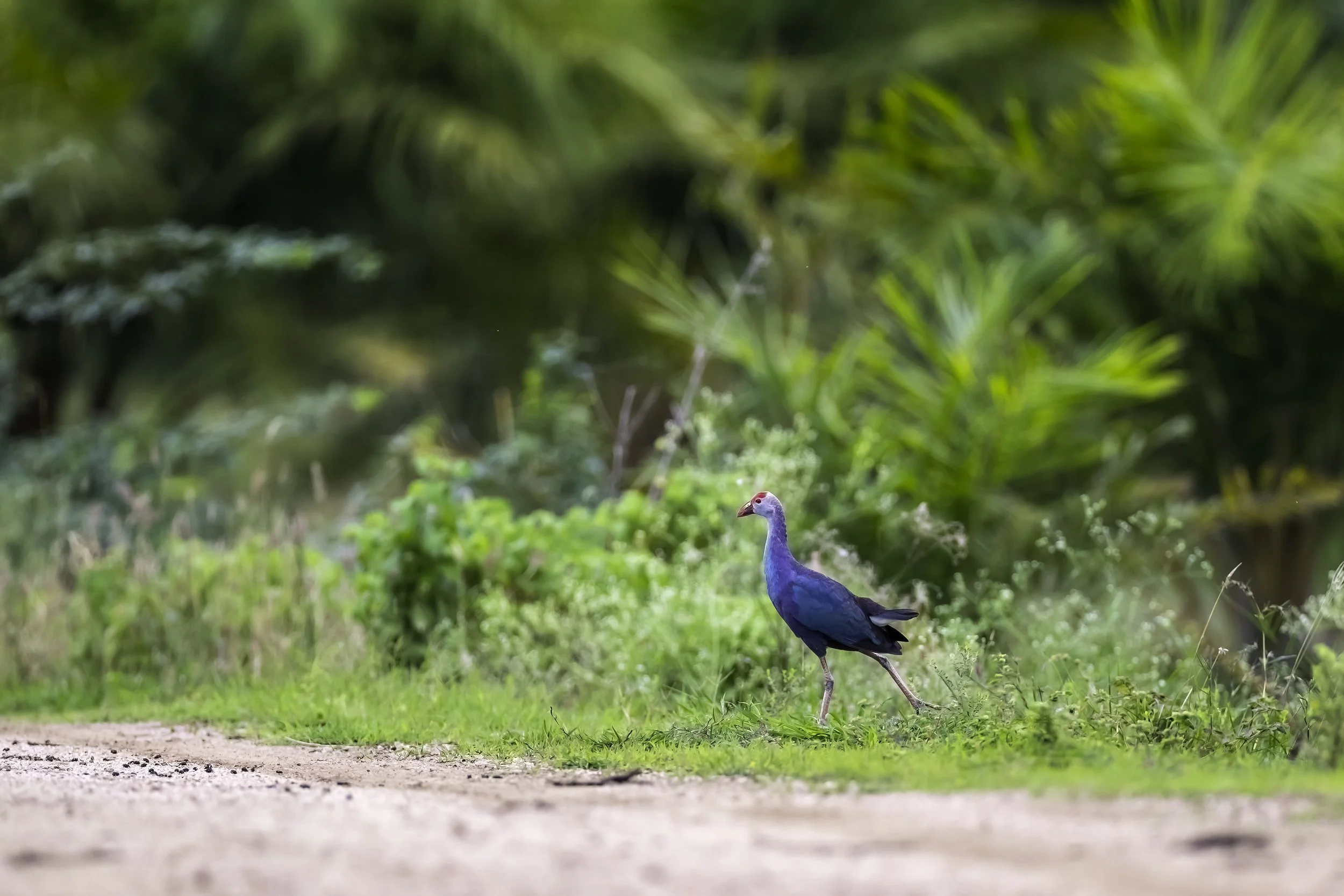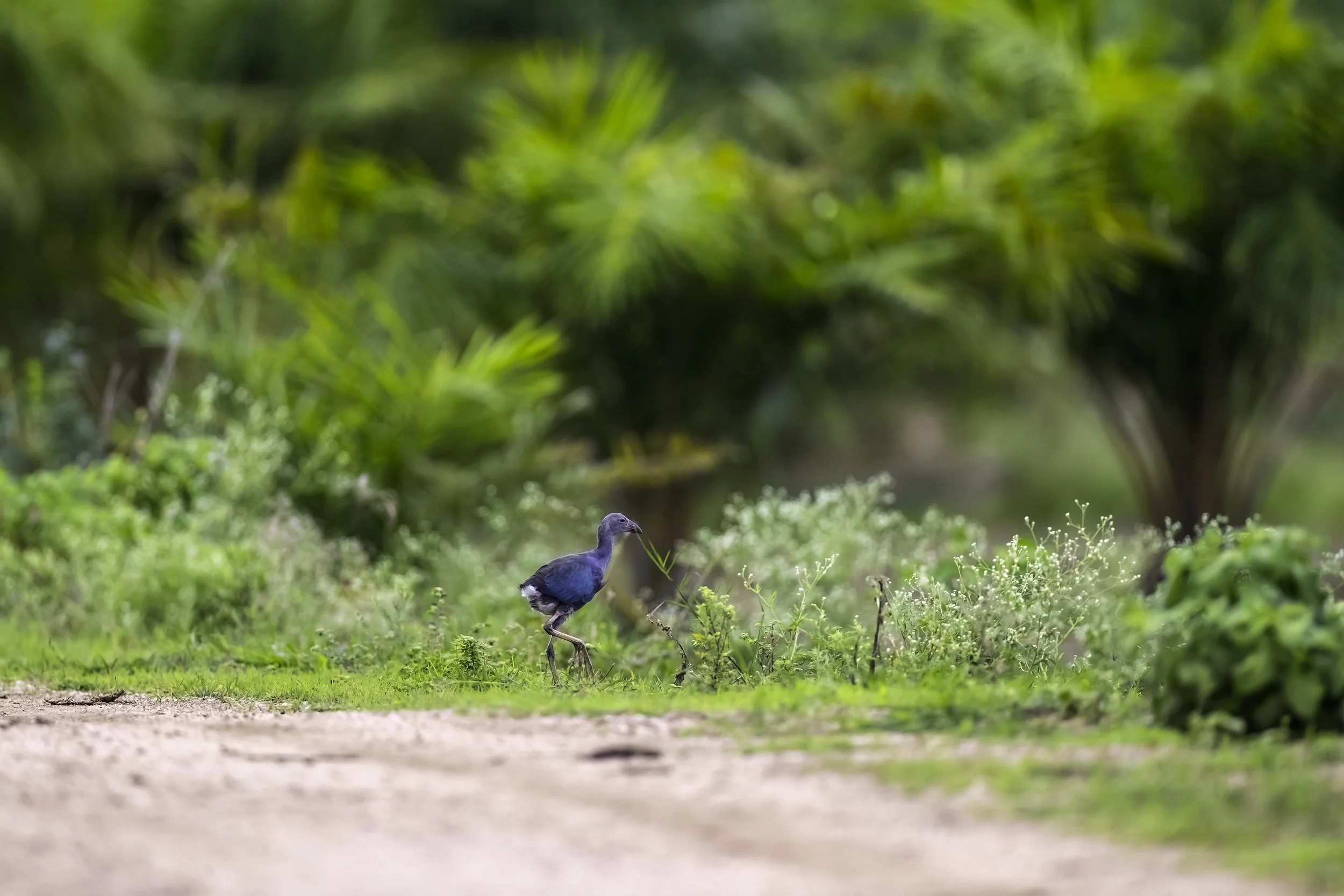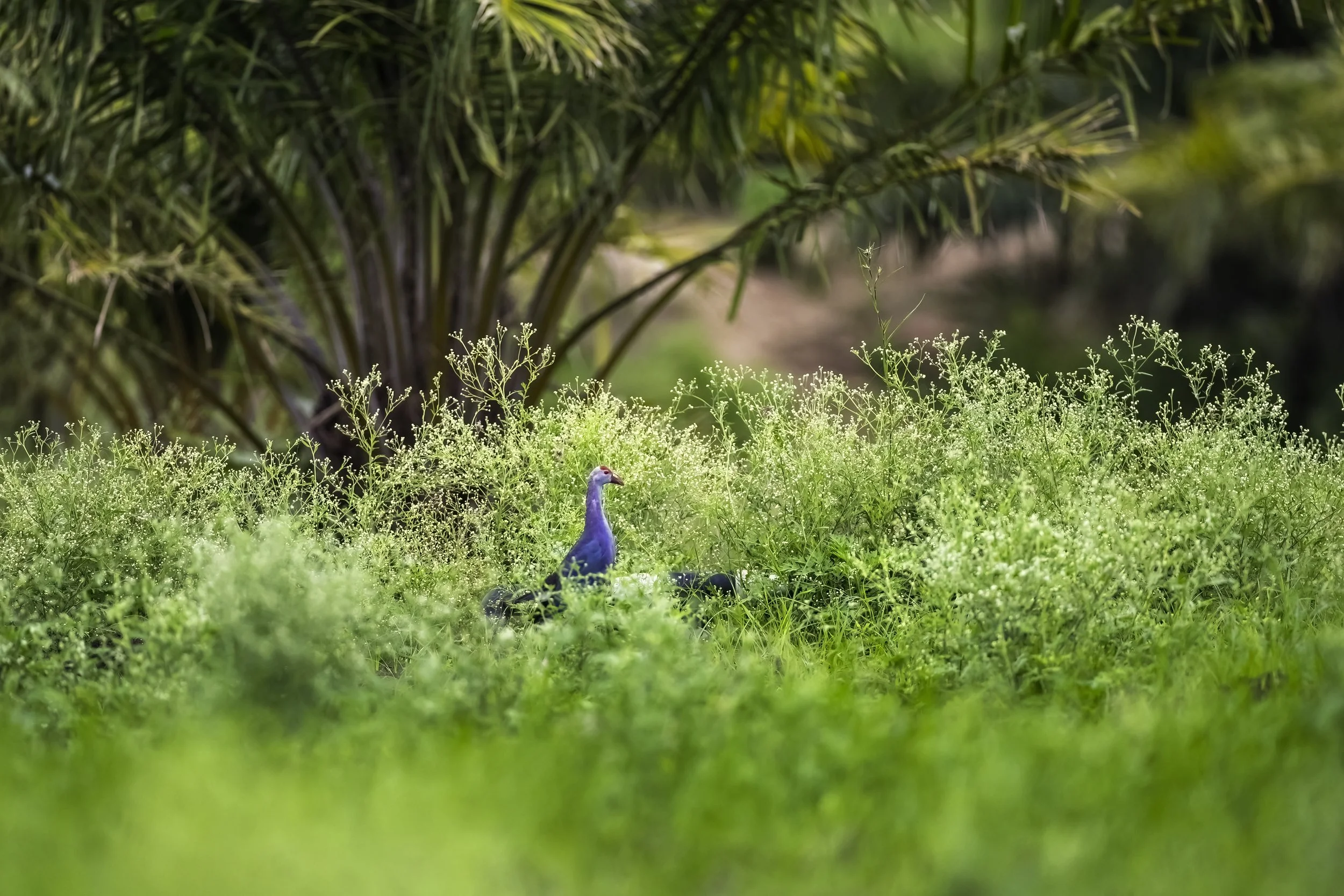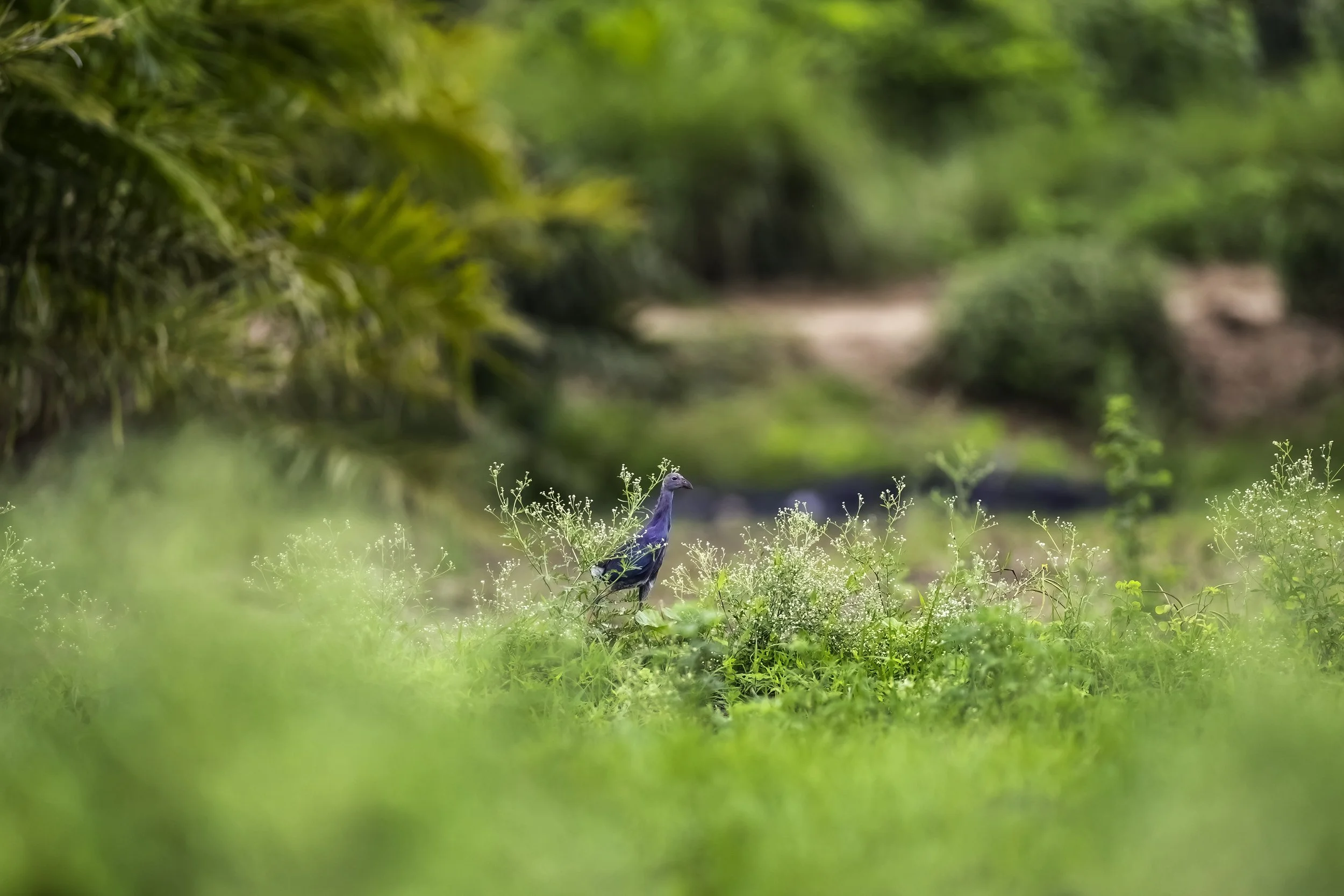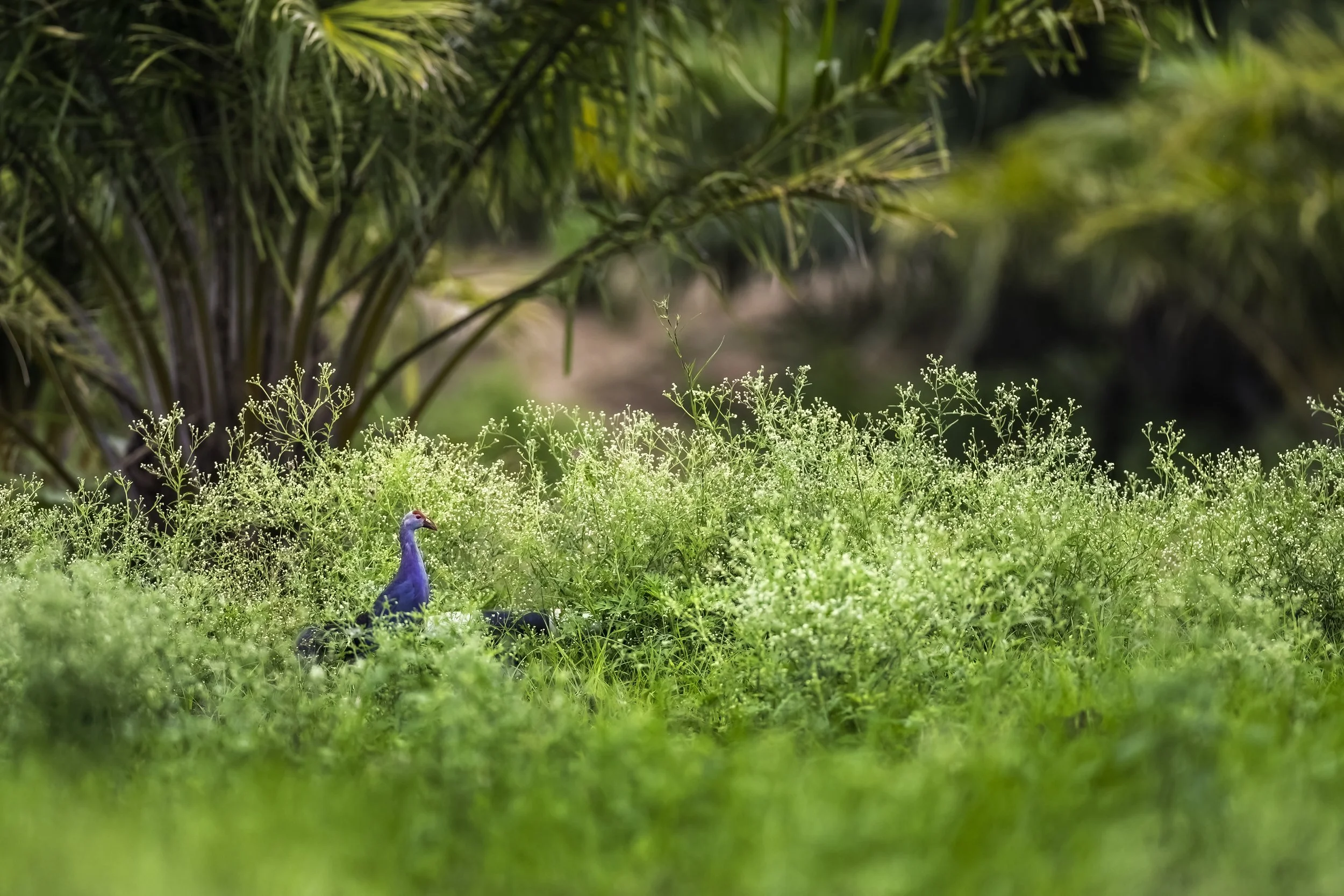Grey-headed Swamphen
Porphyrio poliocephalus
All over India
Swamphens, belonging to the genus Porphyrio in the rail family (Rallidae), are a group of large, colorful waterbirds found in the warmer regions of the world. They are distinguished by their bright plumage, large feet, and often have a prominent frontal shield on their forehead. They are typically characterized by a stout red bill, red or reddish legs and feet with long toes, and a bluish-purple body. Their tails are often flicked upwards, revealing a patch of white undertail coverts. Several taxonomic authorities now split the Purple Swamphen complex (Porphyrio porphyrio) into six distinct species:
Western Swamphen (Porphyrio porphyrio)
African Swamphen (Porphyrio madagascariensis)
Grey-headed Swamphen (Porphyrio poliocephalus)
Black-backed Swamphen (Porphyrio indicus)
Philippine Swamphen (Porphyrio pulverulentus)
Australasian Swamphen (Porphyrio melanotus)
Beyond this core group, other species are also classified within the genus Porphyrio, including:
South Island Takahe (Porphyrio hochstetteri)
Allen's Gallinule (Porphyrio alleni)
American Purple Gallinule (Porphyrio martinica)
Azure Gallinule (Porphyrio flavirostris)
This brings the total number of extant (living) species in the genus Porphyrio to at least ten, though some sources may consider additional species or fewer depending on the classification system used. Today is about my encounter with the Grey-headed Swamphen (Porphyrio poliocephalus) - a large, colorful waterbird within the rail family, Rallidae. It was formerly considered a subspecies of the Purple Swamphen but was recognized as a distinct species in 2015 - differentiated primarily by their head coloration and geographical distribution. They share many physical and behavioral traits characteristic of the swamphen genus. The Grey-headed Swamphens’ native range spans from the Middle East and Indian subcontinent to Southern China and Northern Thailand. In North America, it is considered an introduced species, having become established in Florida due to accidental releases in the 1990s.
Located in the central stretch of the Deccan Plateau, Telangana has sub-tropical climate and the terrain consists mostly of hills, mountain ranges, and thick dense forests covering an area of 27,292 km². The annual rainfall ranges between 1,100 mm to 1,200 mm and the annual temperature varies from 15 C to 45 C. The State is drained by a number of rivers which include the Godavari and the Krishna rivers.
Three National Parks and nine Wildlife Sanctuaries constitute the Protected Area network of the State covering 5.08% of its geographical area and our focus area today is the northern eastern part of the state and the Kawal Tiger Reserve. The Kawal Tiger Reserve lies within the Jannaram mandal of Adilabad district. The Government of India declared the Kawal Wildlife Sanctuary a Tiger Reserve in 2012 and HyTiCoS was a key influencer in this decision. At present the reserve has a low tiger density but promises tremendous potential as a source area with stepped up protection and habitat amelioration under Project Tiger. The Kawal Wildlife Sanctuary was established in 1965 and later declared as a Protected Area (PA) in 1999 under the WPA, 1972. Incidentally, when I went through my photographs over the years, I realized that a lot of the wild and birdlife I had photographed were from the areas in the Godavari River basin and its tributaries. Read about them here.
Water bodies make up a small portion (0.6%) of Telangana's total forest cover. Telangana includes about 79% of the Godavari River catchment area and roughly 69% of the Krishna River catchment area. In May 2022, 69% of the state had groundwater at less than 10 meters below ground level - which hopefully can be improved by the restoration of the almost 600 stepwells scattered across the state. Read my piece on the restoration of the Bansilalpet Stepwell and watch the film - The Sound of Water. The state has a wide network of water bodies, including major rivers like the Godavari and Krishna and their tributaries (Manjira, Musi, Bhima, and Tungabhadra). It also has numerous lakes and reservoirs, such as Hussain Sagar Lake, Osman Sagar Lake, and the Nagarjuna Sagar Dam. While a specific percentage isn't available, the state has a significant water network important for its ecosystem and the people.
Telangana is quite favorable for waterbirds, especially during the winter months when numerous migratory species arrive from colder regions. Telangana has numerous wetlands and water bodies and boasts a good number of lakes, tanks, and other wetlands, including the Manjeera Wildlife Sanctuary - a key habitat for both resident and migratory species, including those who breed there; the Ammavaripeta Cheruvu near Warangal, a haven for diverse wetland birds and lakes like Ameenpur, Osman Sagar, and Himayat Sagar in and around Hyderabad, which are popular destinations for various waterbirds.
These wetlands and surrounding agricultural fields provide crucial feeding, nesting and roosting grounds for various species. Paddy fields, for example, are now acting as important feeding areas for some waterbirds, according to a report on the Asian Waterbird Census. Telangana also falls along migratory routes, attracting birds from Europe, Central Asia, and other regions seeking warmer climates during winter.
However, it's also important to acknowledge the challenges faced by these waterbirds in the state. The primary challenge is Habitat loss and Degradation - encroachment on wetlands, pollution, and the conversion of these vital areas for other purposes are among the primary threats. These water bodies also suffer from pollution, impacting the health and populations of waterbirds, and finally poaching. Illegal hunting remains a concern for some species, as evidenced by the recovery of birds tagged in Russia that were shot by hunters.
In summary, while Telangana provides a generally suitable environment for waterbirds, ongoing conservation efforts are vital to protect these valuable habitats and ensure the continued well-being of both resident and migratory species.
Grey-headed Swamphen
The Grey-headed Swamphen (Porphyrio poliocephalus) is a large, colorful waterbird within the rail family, Rallidae. It was formerly considered a subspecies of the Purple Swamphen but was recognized as a distinct species in 2015. Today the purple swamphen is considered a superspecies and each of its six subspecies groups are designated full species. The Grey-headed Swamphen occurs from the Middle East and the Indian subcontinent to southern China and northern Thailand.
They are large, chicken-sized birds, with males averaging 1,050 grams and females averaging 850 grams (Callaghan 2015, Callaghan and Gawlik 2016). They measure 38–50 cm in length with a wingspan of 90–100 cm (Taylor 1996). The adults have vibrant purplish-blue bodies, often with a greenish sheen on their backs and wings with heads that are typically grayish or pale blue, and they sport a bright red bill and frontal shield on their foreheads. They have orange-red legs and feet with long toes, and their tails are short, often flicked up to reveal white undertail coverts. Eyes are orange to red and they are mildly sexually dichromatic, with the heads of females being mostly blue while those of males mostly grayish (D. Williams, personal communication). As is typical among Rallidae, males are larger and heavier than females. The juvenile Gray-headed Swamphen are duller-colored than adults and have dusky bare parts and the chicks of Rallidae are generally indistinguishable at a young age until features of the bill are more developed. The group is believed to have originated in Africa in the Middle Miocene epoch & subsequently spread across the world.
The Gray-headed Swamphen has 10 functional primaries, 9–10 secondaries (including 3 tertials), and 12 rectrices. The wings are moderately rounded (p6, p7, or p8 is the longest primary), the tail is short, and the bill, legs, and feet are strong. The molt and plumage descriptions pertain to the subspecies P. p. poliocephalus of eastern continental Asia and India, as well as Florida. No geographic or sex-specific variation in overall molt strategies has been reported. Variation in plumage color and pattern, bare part color, and body size is fairly limited across this species’ geographic range.
The Grey-headed Swamphen is one of 15 species in the genus Porphyrio.
Subspecies
Porphyrio poliocephalus poliocephalus Latham, 1801: The nominate subspecies. Found from India (including the Andaman and Nicobar Islands) and Sri Lanka to southern China and northern Thailand.
Porphyrio poliocephalus seistanicus Zarudny and Härms, 1911: Found from Iraq and southern Iran to Pakistan, Afghanistan, and north western India. There is also an introduced population in Florida.
Porphyrio poliocephalus caspius Hartert, 1917 : Found near the Caspian Sea, northwestern Iran, and Turkey.
The Grey-headed Swamphen (Porphyrio poliocephalus) was once considered a subspecies of the Purple Swamphen (Porphyrio porphyrio), but recent taxonomic updates have elevated it to a distinct species. The key difference lies in their plumage and geographical distribution.
Head Coloration: While both species have a generally purplish-blue body, the Grey-headed Swamphen is distinguished by its slate-grey head and neck, contrasting with the deep blue of its body. The Purple Swamphen typically has a darker purplish or bluish head that blends more with its body plumage.
Geographic Range: The Grey-headed Swamphen's native range extends from the Middle East and Indian subcontinent to Southern China and Northern Thailand. The Purple Swamphen is found in southwest Europe and northwest Africa.
Although the Gray-headed Swamphen is predominantly sedentary within its native range, Porphyrio are known to disperse long distances (> 300 km) in response to unsuitable water levels (e.g., Vielliard 1973, Sánchez-Lafuente et al. 2001), and such dispersal has been documented in Florida (Pranty 2012). Their excellent dispersal ability combined with the abundance of an important food plant in Florida, the Gulf Coast spikerush (Eleocharis cellulosa; Pranty 2013a, Callaghan and Gawlik 2016), has raised concern among wildlife managers about further expansion of the species. As a result, additional research on the potential impacts to native flora and fauna is badly needed.
Porphyrio swamphens are widely distributed from western Europe and Africa through Asia, Australia, New Zealand and islands in the Pacific (Taylor 1996, Sangster 1998, Taylor 1998), but the Grey-headed Swamphen extends from the Middle East through India & Southern Asia to Northern Thailand. Throughout their range, Porphyrio swamphens demonstrate a remarkable ability to disperse. Grussu 1999 summarised the dispersal ability of swamphens throughout Europe. Interestingly, an apparent African Swamphen at Bernard Park, Bermuda in October 2009 (Pranty 2013a) may have travelled more than 10,000km if a natural vagrant. Their winter range is the same as the breeding range and they are non-migratory but disperse in relation to water levels.
They inhabit a variety of freshwater wetland environments including marshes, swamps, lakes, ponds, and even human-modified areas like golf courses and flooded fields. They are known for adapting well to such environments. Grey-headed Swamphens are omnivores, primarily feeding on plant matter such as shoots and tubers of aquatic plants. They are also opportunistic feeders and may consume insects, fish, amphibians, reptiles, and even other birds' eggs and nestlings.
They are diurnal and primarily forage by wading in shallow water or on floating vegetation. They use their strong bills and long toes to pull up and manipulate plants. While they prefer running or swimming, they are capable of flight, although it may appear clumsy. They are known to have elaborate courtship displays where the male bows to the female while holding water weeds in his bill. They exhibit diverse social structures, including communal breeding.
Swamphens exhibit diverse social structures, including monogamous pairs and communal breeding groups. In communal groups, multiple individuals, both males and females, contribute to territory defense, nest building, incubation, and raising the young. Females in communal groups may even share a single nest and lay their eggs in it.
Conservation Status: The Grey-headed Swamphen is not recognized as a globally red-listed species. However, in Florida, it's considered an invasive species, and there have been concerns about its potential impact on native wildlife.
In conclusion, the Grey-headed Swamphen is a striking and adaptable bird with a wide native range across parts of Asia and an established non-native population in Florida,
‡‡‡‡‡
For a print of the beautiful birds from my various sojourns click on the button below to read my process and order a limited edition canvas.
‡‡‡‡‡
Related Posts

